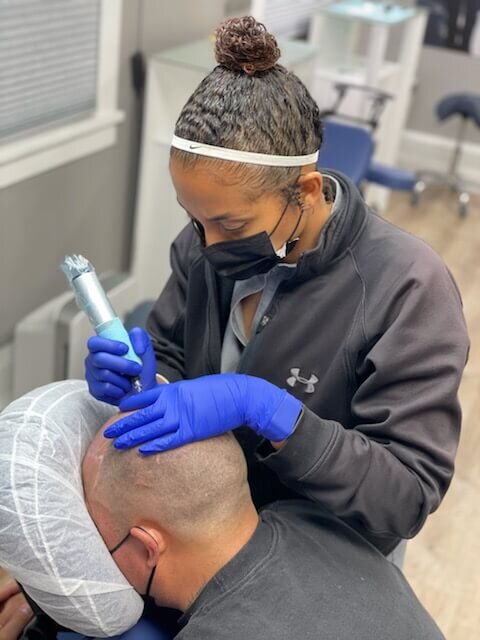Approximately 12% of women experience symptoms of premature hair loss by the age of 29
Approximately 12% of women experience symptoms of premature hair loss by the age of 29. The number of women affected by early hair loss increases with age. This makes it essential for all women to learn about hair loss prevention for women, regardless of their age.
In this article, we discuss the causes of early hair loss as well as the steps you can take to stop hair loss. Continue reading if you want to maintain or regain your full head of hair.
Causes of Early Hair Loss
Part of preventing hair loss is understanding the causes. While most of these are outside of your control, learning about them can help you understand your options to stop hair loss.
Hormonal Changes
A change in your hormones can result in premature hair loss. Both men and women need testosterone, which helps produce other hormones. When these hormones change, hair follicles shrink and the hair stops growing.
Menopause
Women start seeing early hair loss due to menopause as early as their 30s. The process triggers changes in hormone production. It begins with a gradual thinning of the hair but can be stopped with the right treatments.
Thyroid
Thyroid issues are another common reason why women experience premature hair loss. Both hypothyroidism and hyperthyroidism can trigger it.
One of your thyroid's jobs is to help produce new hair and maintain this process. Changes in the thyroid discourage this process and can even make your hair dryer and prone to breakage.
Genetics
Genetics is a primary role in hair loss for men, but it also plays a role for women. Women experiencing hereditary hair loss produce thinner strands of hair that are less pigmented and fall out easier.
Stress
Stress takes a physical toll on your body in many ways including your ability to maintain a healthy scalp-full of hair. The process of hair loss due to stress is known as telogen effluvium.
Your hair will suddenly become thinner and easier to fall out or break apart and replacement hairs may not grow back. Fortunately, stress-related hair loss isn't permanent.
Weight Loss
Losing weight too quickly and/or not consuming the proper nutrients can result in physical strain on your body. This causes the development of telogen effluvium. Adjusting your weight loss approach can help restore your hair health.
Hair Loss Prevention for Women
Now that you know the causes of early hair loss, you can start taking the necessary steps toward hair loss prevention for women. Learning how to prevent hair loss involves adjusting all parts of your routine for the best results.
Staying committed to the process of preventing hair loss is essential. Even if you find adjusting your routine isn't enough, there are still other options to help stop hair loss.
Wash Hair with Care
How you wash your hair could be contributing to or exacerbating early hair loss. Washing too aggressively and frequently are examples of this.
It's important to only wash your hair when it absolutely needs it. Washing out your natural oils too frequently can leave your hair dry and brittle.
The longer you go without washing your hair, the easier it is for your body to adjust its natural oil production. Aim to wash at most every other day though less frequently is better.
How to Shampoo and Condition
When you shampoo your hair, apply a small amount to your scalp only. This is the greasiest part of your hair and the main part that needs washing. Gently work the shampoo through your scalp and let the water wash it through your strands.
You should only apply conditioner to the strands of your hair. Your scalp relies on its natural grease product for moisture and the conditioner can just weigh it down.
Avoid Heat and Friction
Heat is your hair's worst nightmare. It can suck out the moisture and leave it vulnerable to breakage. If you can, we recommend allowing your hair to air dry instead of using a hairdryer.
We also recommend against using rough towels on your hair. This causes a lot of friction and damage. It's especially harmful to wrap your hair in a rough and heavy towel that can pull on your delicate strands.
Minimize Hairstyle Strain on Your Strands
The way you style your hair can be a big problem, especially if you're working on hair loss prevention for women. Your strands are at their most vulnerable when they're wet, which is why we recommend leaving them alone until they air dry completely.
If you need to work through tangles, grab a wide-tooth comb instead of a bristle brush. Otherwise, you risk pulling and tearing your strands.
Once your hair is dry, keep your buns and ponytails as loose as possible. Better yet, wear it naturally. Tight buns and high ponytails stretch your hair and cause breakage every time you wear them.
Use the Right Products
An important part of hair care is the products you use to stop hair loss. Invest in products such as quality shampoos, conditioners, and leave-in conditioners.
Examples of ingredients that help promote hair growth include lavender oil, peppermint oil, and aloe vera. However, it's always a good idea to talk with your doctor or dermatologist before using new products.
Scalp Micropigmentation
Trying to stop hair loss can be a difficult process, especially if you've already lost a noticeable amount of hair. Scalp micropigmentation can help fill in patches of exposed scalp.
Scalp micropigmentation can make your hair appear fuller. Plus, it helps create a more natural-looking hairline.
Take the Right Steps Toward Hair Loss Prevention for Women
Taking the right steps toward hair loss prevention for women starts with the above guide. Talk with your doctor about any potential causes of hair loss and treat your hair kindly when washing, drying, or styling to minimize damage.
To learn more about scalp micropigmentation, contact us today.


